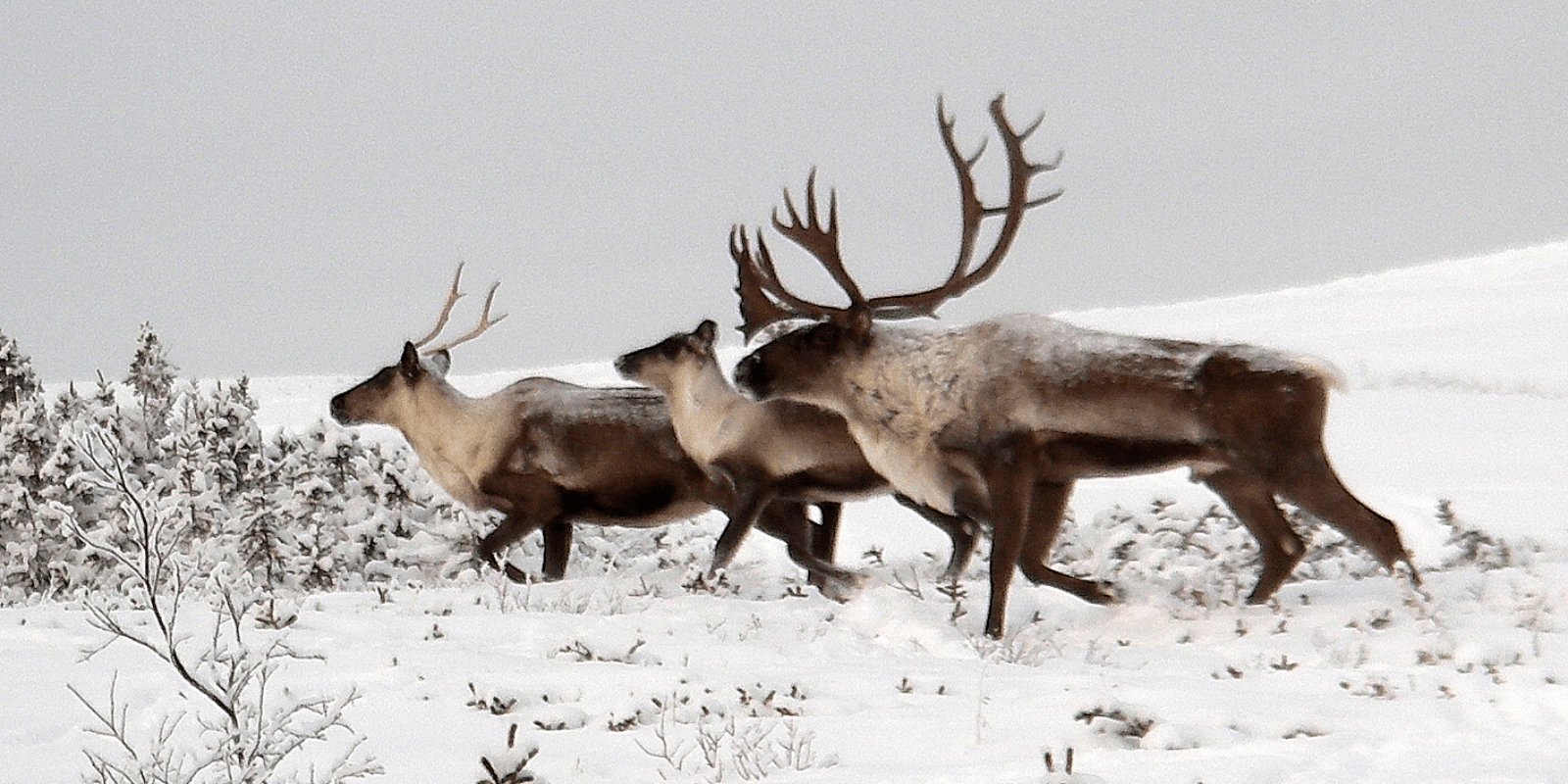We have much more to do and your continued support is needed now more than ever.
Rescuing Reindeer: Caribou on the Brink
Caribou are extinct in the lower 48 states

Due in part to their signature antlers and magical characterization in popular holiday tales, reindeer are ubiquitous throughout the winter season. Caribou, as reindeer are called in North America, used to call most northern U.S. states home. Their decline in the lower 48 states reached a sorrowful conclusion in 2018, when the last wild caribou that migrated back-and-forth from British Columbia to Idaho was relocated as part of Canadian caribou recovery efforts. Deforestation, parasites, and booming deer populations perpetuated the decline of Idaho’s herds for decades, with herds like those of the Selkirk Mountains dwindling on life-support for almost 35 years.
Remaining native populations, like the porcupine caribou herd, can be found in Alaska, though they are threatened by a warming habitat and oil and gas leasing in the Arctic National Wildlife Refuge.
But fear not, there is hope on the horizon: As the National Wildlife Federation continues to fight to protect the caribou’s home in the Arctic National Wildlife Refuge, we are also talking with tribes and other wildlife champions about legislation and other strategies to restore the caribou to their ancestral range.
Learn 6 facts about caribou — and how you can support their restoration!
#1: Yoo-hoo, Baby Caribou!
According to the University of Michigan, most female caribou will give birth to a single calf, normally in May or June. Although calves can suckle almost immediately, they are also able to graze grass shortly after birth. Incredibly, caribou calves can follow their mother an hour after birth and outrun a human within their first day. With a typical lifespan of 15 to 18 years, caribou grow antlers around their second birthday.
#2: All together now: Head, Antlers, Knees & Hooves, Knees & Hooves
Caribou have adapted to the rugged snow-covered terrain of the global north. They use their wide, hollowed out hooves to scoop out lichen from under snow and their shape changes with the seasons – or to stand on top of snow to reach lichen growing on trees. According to the Denali Education Center, in the winter hooves are longer, and pads are tougher and protected by heat-retaining hair; and in summer, the pads are larger and touch the ground.
Many experts believe that the clicking noise caribou make when they walk helps herds stay together in fog and snowstorms.The click is generated by a tendon moving in their feet with each step.
#3: A Warming Landscape: Lichen Losses
With increasingly frequent high temperatures and wildfires in Alaska, lichen — a significant source of nutrients for caribou — is being dried out or burnt. To make things worse, lichen takes around 80 years to regrow! Although caribou consume shrubs and moss, a study found that “lichens constituted ~ 71% of the late winter diets of caribou in northwest Alaska.”
#4: Peril in the Arctic National Wildlife Refuge
Although there is uncertainty in forecasting the direct impact of oil drilling in caribou calving habitat in the Arctic National Wildlife Refuge, scientists have pointed out two areas of concern.
From studies in the 1980s and 1990s, the U.S. Geological Service found that caribou avoid areas within “6 kilmoters of roads and wells” from oil development. And a 2002 USGS modeling study suggested a lower food supply and greater exposure to predators could lead to a “survival rate of caribou calves [dropping] by as much as 8%.”
Some researchers at the University of Massachusetts suggest an even greater impact, noting:
“The study found that when subjected to the harshest development scenario of 15 [oil] rigs, all open for leasing, the caribou lost 34% of their habitat used for calving grounds when they were forced out of it by drilling the effects (Wilson et al., 2015). Excessive noise levels from the drilling activity causes these animals to migrate from their high-quality sites into areas that are less suitable for their needs (Drolet et al., 2016).”
#5: A Caribou By Any Other Name: Tribal Connections
Caribou are a vital part of some Tribal cultures in the U.S. and Canada. The name word, “caribou”, is derived from a French derivation of the Miꞌkmaq word “qalipu.” In Mi’Kmaq, an Eastern Algonquian language, the word translates as “snow shoveler.”
Caribou have long been extirpated from the northern Midwest and New England habitats where Chippewa and Algonquin tribes once encountered them. For these Tribes, caribou represented watchfulness and perseverance.
The Kalispel and Kootenai tribes of the U.S. Northern Rockies have the most recent tribal relationship with wild caribou south of what is now the Canadian border, and are working hard to bring them back.
Familiar to many following the fight against drilling in the pristine Arctic National Wildlife Refuge, the Gwich’in people value caribou for the sustenance they provide spiritually, nutritionally, and economically.
In a guest blog, Matthew Gilbert of Arctic Village, Alaska wrote these moving words:
The Porcupine Caribou Herd has sustained our people and our culture for nearly 20,000 years. Our campaign to protect the refuge is our way of helping to protect this vital resource. We are not against oil & gas development, although we do not promote it in sensitive regions. We do promote alternative energy to sustain our modern society as all the world should. One hundred years ago our people were nomadic, yet today our small village has already established solar panels and recycling programs. The world needs to move in the direction of renewable energy. It is our only hope, it is the Porcupine Caribou Herd’s only hope, and it is the only hope of the Gwich’in people.
#6: Hoofin’ It: Migration of Alaska’s Caribou
Did you know the distance that a caribou herd migrates is oftentimes associated with the size of the herd? According to the U.S. Fish and Wildlife Service, the porcupine caribou herd of Alaska, “which contains about 169,000 animals, migrates between summer and winter ranges that are about 400 miles apart” and “travel[s] over 3000 miles per year.” That’s a lot of mileage!
How you can help the caribou
Now that you are a caribou expert, share these facts with your friends and family over hot coco this winter! And after legislation is introduced, we’ll need each and every wildlife advocate like you to speak out for caribou restoration.
You can support our work for wildlife this winter by giving a gift today.
Donate!






















